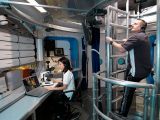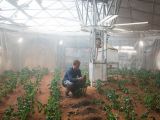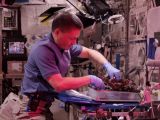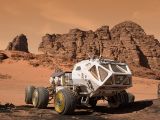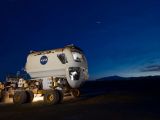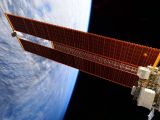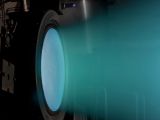Ridley Scott's “The Martian” will open in theaters in just a few weeks. By all accounts, it's labeled a sci-fi film. Except that, as it turns out, there's more cold, hard science to this space movie than some might think.
For those who aren't all that familiar with the plot, “The Martian” tells the story of a failed mission to Mars than ends with one astronaut (Mark Watney / Matt Damon) being left behind on the Red Planet and presumed dead.
While waiting to be rescued, the astronaut has no choice but do his best to survive and try to come up with a way to communicate with base. Finding food and water, as well as proper shelter, are just some of the problems he faces.
What's really cool is that, although an actual manned mission to Mars has not yet happened, many of the technologies featured in the movie are now in the works over at NASA. Without further ado, here's some of them:
Astronaut habitats
The agency is dead set on sending people to Mars. When they finally get there, the first Mars explorers won't sleep in tents or anything of the kind. Rather, they'll get special habitats to call their home.
Like Mark Watney's habitation module, the ones now being developed by NASA will serve as living quarters. Mind you: a simulated deep-space habitat already exists. It's called HERA (the Human Exploration Research Analog) and sits on the premises of NASA's Johnson Space Center.
Presently, the space agency has crews live for up to 14 days in this simulated deep-space habitat, during which time experts keep tabs on their overall health and their behavior. The data is intended to predict how being forced to live together for days on end might affect astronauts.
Plant farms for space food
In “The Martian,” astronaut Mark Watney turns his habitation module into a farm and gets into the business of growing potatoes. Now, if you think growing vegetables in space is pure fiction, guess again. It's been done before and it worked out great.
In fact, it was just days ago that astronauts aboard the International Space Station made themselves a salad from red romaine lettuce grown high up in orbit. Their verdict: it was quite delicious.
Recovering water
There are some rumors going around that Mars was once home to mammoth seas and oceans, but the fact of the matter is that, at least these days, the planet is a frustratingly dry and desolate place.
To survive, Mark Watney has to recover and reuse every single drop of water. Courtesy of recent technological advances, this is already done aboard the International Space Station, where sweat, tears and even urine are recovered, filtered and purified, and then reused. As one astronaut put it, “Yesterday’s coffee turns into tomorrow’s coffee.”
Always the perfectionist, NASA is working on developing new technologies to recover and recycle water, the end goal being to find a way to ensure future deep space explorers have all the water they might need without having to look to Earth for extra supplies.
Generating oxygen
If there's one thing we humans can't go without for more than a few minutes, that's oxygen. Here on Earth, there's plenty to go around and so this life-sustaining chemical element almost never crosses our mind. On Mars, however, access to oxygen can prove quite a hassle.
In “The Martian,” Mark Watney takes care of this problem with the help of a system designed to produce oxygen from the carbon dioxide coughed out by a fuel generator.
This technology is already employed aboard the International Space Station, where a similar system constantly reprocesses the spacecraft's atmosphere and coughs out just enough oxygen to make the air breathable. This system produces oxygen by breaking apart water molecules.
Rovers for transport
There are no buses on Mars - well, not as far as we know - so astronaut Mark Watney turns to a rover to get around. Similar vehicles, designed to be robust, reliable and versatile, will be used by the first people sent to explore the Red Planet.
NASA is now hard at work perfecting and testing one such rover, the Multi-Mission Space Exploration Vehicle, which it hopes will one day be used to navigate landscapes not just on Mars, but also on other celestial bodies like, say, asteroids.
Choosing the right spacesuit
Here on Earth, we can wear pretty much whatever we want. When they make it on Mars, however, astronauts will have to put on spacesuits, especially when leaving the comfort of their habitation modules and setting out to explore local landscapes.
Such spacesuits will not only protect them from exposure to radiation and dust but will also provide them with the oxygen they need to stay alive. Basically, they will function like mobile, miniature habitats made to be worn.
Solar panels for energy
Admittedly, the first crews to land on the Red Planet will bring some fuel with them. Be that as it may, it is expected that, with the help of solar panels, they will manage to generate their own energy. This energy will either be used to power ongoing operations or stored for later.
The International Space Station is fitted with a total of four sets of solar arrays with a combined output of 84 to 120 kilowatts. NASA expects such solar arrays will not only deliver energy to habitation modules on Mars at some point in the future, but will even power spacecrafts carrying crews to the planet.
Yet another energy source
There's no such thing as too much energy, especially not when it comes to trying to colonize an alien planet, NASA seems to think. Hence, solar panels aren't the only technology the space agency is looking into.
There's also Radioisotope Thermoelectric Generators (RTGs, for short), which the agency describes as space batteries designed to produce electric power from the heat released by the natural radioactive decay of plutonium-238.
This technology, a favorite of NASA's for about 40 years now, is too featured in “The Martian,” with Mark Watney and his crew relying on a plutonium-based RTG power source to keep their Mars Ascent Vehicle up and running.
Ion propulsion
In “The Martian,” the spacecraft carrying the astronauts all the way to Mars and then back to Earth is powered by ion propulsion. This technology might sound sci-fi, but it really does exist. It's what made it possible for the Dawn spacecraft to reach the asteroid Vesta and dwarf planet Ceres.
“Ion propulsion works by electrically charging a gas such as argon or xenon and pushing out the ions at high speeds, about 200,000 miles per hour [over 320,000 kilometers per hour],” NASA explains.
“The spacecraft experiences a force similar to that of a gentle breeze, but by continuously accelerating for several years, celestial vessels can reach phenomenal speeds,” the agency further details.
So, not such a sci-fi movie after all
It will be a few years before the first humans leave Earth and head out for Mars, but, by the looks of it, such a space adventure will undoubtedly happen at some point in the future. We can only hope we'll live long enough to witness it.
As for Ridley Scott's “The Martian,” even NASA agrees this isn't your usual sci-fi film. There's actual science happening, science like the one that will one day land us on Mars for real.
“Although the action takes place 20 years in the future, NASA is already developing many of the technologies that appear in the film,” the space agency says.

 14 DAY TRIAL //
14 DAY TRIAL // 

